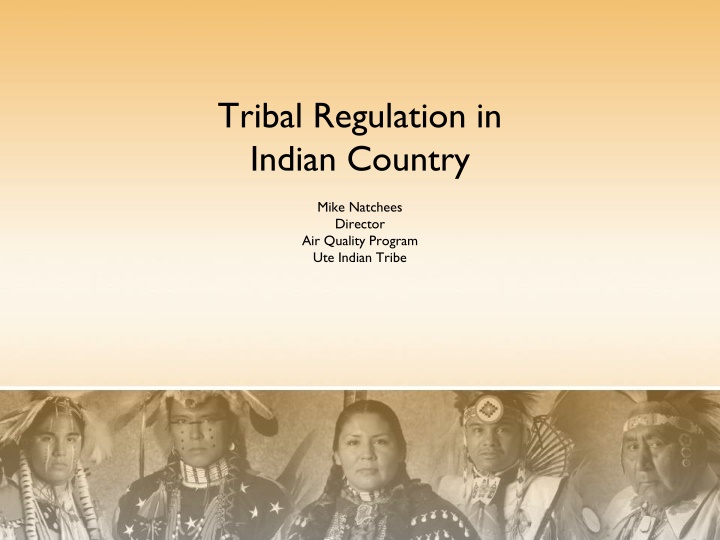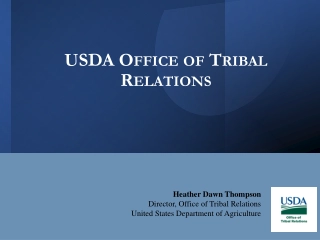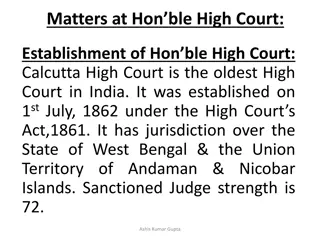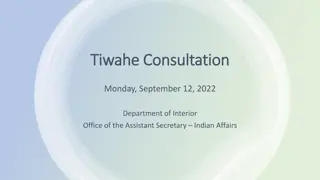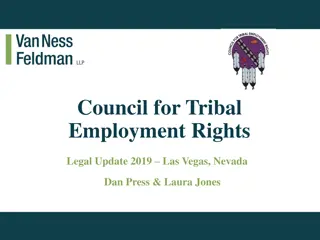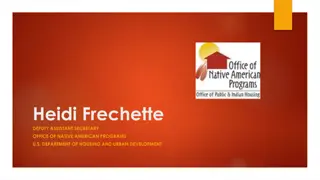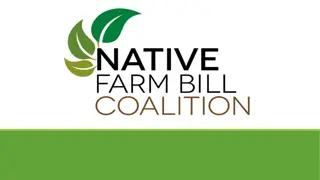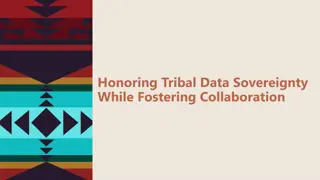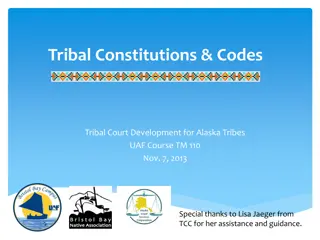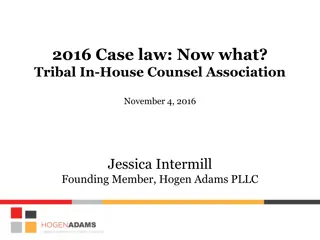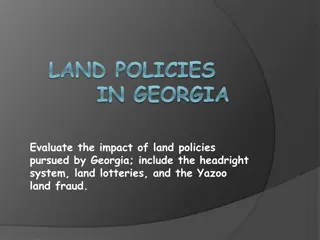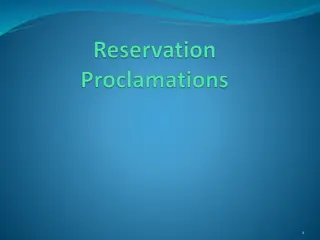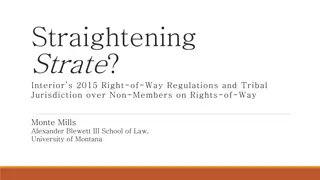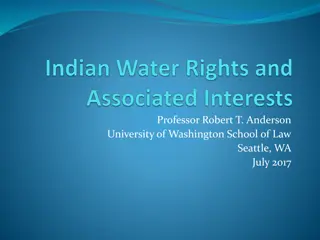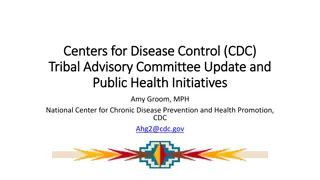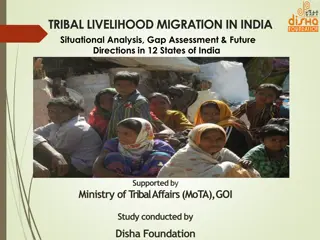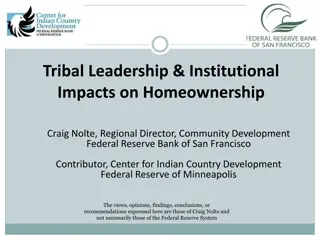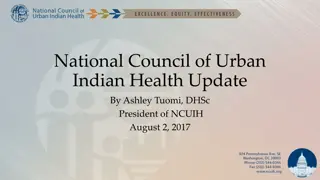Tribal Regulation in Indian Country - Jurisdiction and Land Rights
The Ute Indian Tribe's Constitution and Tribal Code establish the Tribe's territorial jurisdiction over Indian Country, including lands within reservations. This includes natural resources, airsheds, waters, minerals, and more. Federal laws and court decisions further shape the boundaries of tribal jurisdiction. The definition of Indian Country as per 18 U.S. Code 1151 encompasses Indian reservations, dependent communities, and Indian allotments with unextinguished titles. Explore the intricate legal framework governing tribal land rights and jurisdiction within the Ute Indian Tribe's territories.
Download Presentation

Please find below an Image/Link to download the presentation.
The content on the website is provided AS IS for your information and personal use only. It may not be sold, licensed, or shared on other websites without obtaining consent from the author.If you encounter any issues during the download, it is possible that the publisher has removed the file from their server.
You are allowed to download the files provided on this website for personal or commercial use, subject to the condition that they are used lawfully. All files are the property of their respective owners.
The content on the website is provided AS IS for your information and personal use only. It may not be sold, licensed, or shared on other websites without obtaining consent from the author.
E N D
Presentation Transcript
Tribal Regulation in Indian Country Mike Natchees Director Air Quality Program Ute Indian Tribe
Tribal Law The Constitution of the Ute Indian Tribe and its Tribal Code is the organic governing document of the Tribe, its members, and its Reservation. Section 1-2-2 of the Constitution and Ordinance 13-010 of the Tribal Code establish the Tribe s Territorial Jurisdiction and Indian Country as the lands within the exterior boundary of the Reservation. The scope of the Tribe s jurisdiction includes its natural resources, including the airshed and water. Congress and decisions of Federal Courts have sought to place further limitations on the boundaries of the Tribe s Reservation and scope of the Tribe s jurisdictional authority.
Tribal Law cont According to Ordinance 13-010, the territorial jurisdiction of the Ute Indian Tribe shall extend to Ute Indian Country which is defined as: all Indian trust lands and non-trust lands within the Uintah Valley Reservation established by the Executive Order of October 3, 1861, except for lands that passed from trust to fee status under the 1902-1905 allotment legislation as determined by the U.S. Tenth Circuit Court of Appeals in Ute Indian Tribe v. State of Utah, 114 F.3d 1513 (10th Cir. 1997); all land within the exterior boundary of the Uncompahgre Reservation as established by the Executive Order of January 5, 1882; all lands conveyed to the Tribe under the acts of Congress of March 11, 1948 (62 Stat. 72), and October 30, 2000 (114 Stat. 1654); all land owned in fee by the Ute Tribe; all rights-of-way and roads within the Tribe s territorial jurisdiction; the air within and airspace above the Tribe s territorial jurisdiction; all minerals and mineral interests owned by or held in trust for the Ute Tribe, and all waters, water storage facilities and irrigation works owned by or held in trust for the Ute Tribe and Ute Indian allottees, including the Midview Reservoir and the property appurtenant to the Midview Reservoir; and all property, minerals and natural resource interests that may hereafter be added to the Tribe s reservations, owned in fee, or held in trust for the Tribe under any law of the United States or otherwise. The jurisdiction of the Courts of the Ute Indian Tribe shall extend beyond the territorial limitation set forth next above, to effectuate the jurisdictional provisions set forth below, to the greatest extent permissible by law.
Definition of Indian Country 18 U.S. Code 1151 defines Indian Country as: (a) all land within the limits of any Indian reservation under the jurisdiction of the United States Government, notwithstanding the issuance of any patent, and, including rights-of-way running through the reservation, (b) all dependent Indian communities within the borders of the United States whether within the original or subsequently acquired territory thereof, and whether within or without the limits of a state, and (c) all Indian allotments, the Indian titles to which have not been extinguished, including rights-of-way running through the same.
Indian Country of the Uintah & Ouray Reservation A series of Tenth Circuit and Supreme Court decisions have further defined what constitutes Indian Country within the Uintah & Ouray Reservation. Ute Indian Tribe v. Utah was a series of cases in the Utah District Court and Tenth Circuit in the 1980s and 1990s, and Hagen v. Utah is a Supreme Court case from 1994. Pursuant to these cases, the Uncompahgre Reservation was never diminished or disestablished, and the Uintah Valley Reservation was diminished only to the extent of lands that were (i) opened to non- Indian settlement under the 1902-1905 Acts, (ii) patented to non- Indians, and (iii) not later returned to Tribal ownership.
Indian Country of the Uintah & Ouray Reservation con t The jurisdiction of the Ute Indian Tribe within the Uintah and Ouray Reservation includes: 1) the Uncompahgre Reservation (original) 2)all trust lands within the Uintah Reservation, including the Uintah National Forest 3)all lands apportioned to individuals terminated by the Tribe by the Ute Partition and Termination Act of 1954 4)all lands allotted to individual Indians that passed into fee status after 1905 5) all lands held in trust after 1905 that were later changed into fee status by the Tribe in exchange for lands that are now held in trust The jurisdiction of the State of Utah within the Uintah and Ouray Reservation includes: 1) unallotted Uintah lands opened to settlement that passed into fee status between 1902-1905
Jurisdiction Over Air Quality Tribes retain inherent sovereign powers to govern their own lands. This includes the ability to set standards and manage environmental programs. Absent congressional authorization states have no authority over tribes internal affairs, land, or resources. The EPA defines Indian Country broadly for purposes of environmental regulation, to be all lands within the exterior boundary of the Reservation, as well as any lands outside the reservation held in trust for the Tribe. The Tribe is a co-regulator of the airshed with the Environmental Protection Agency. The Tribe and its reservation are subject to the Clean Air Act and other federal environmental laws and regulations.
Jurisdiction Over Air Quality cont The federal government claims broad authority over tribes, including in the enforcement of federal environmental laws. However the federal government has a trust responsibility to tribes and is a trustee of tribal lands and resources. The federal government therefore has an obligation to regulate and enforce environmental laws for the benefit of tribes and at the direction of tribes. Tribes can also seek delegation of authority over these programs, which the Ute Indian Tribe is currently in the process of undertaking.
Conclusion The EPA and the Tribe are co-regulators of all Indian Country lands for purposes of the Clean Air Act. Tribes generally have environmental regulatory authority within reservation boundaries over all lands. The Tribe s Indian Country lands consist of all lands within the Reservation Boundary with the exception of unallotted Uintah lands opened to settlement that passed into fee status between 1902-1905, as shown by the jurisdictional map and often referred to as Hagen lands. The state has no jurisdiction or authority on the Tribe s Indian Country lands, and no environmental regulatory authority within the reservation boundary.
